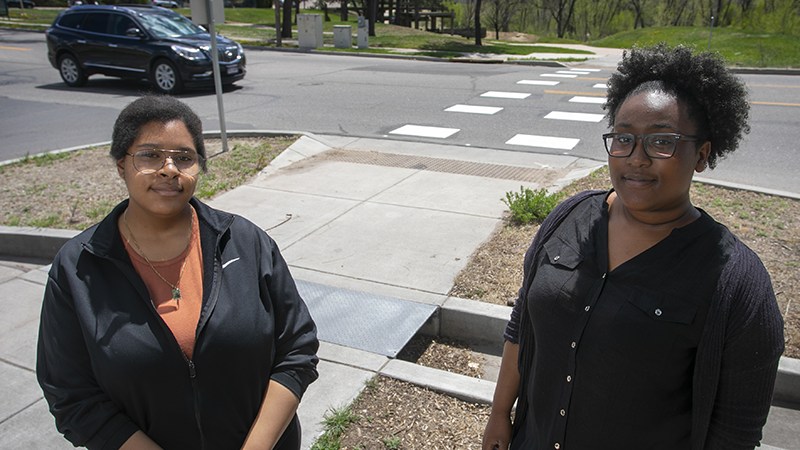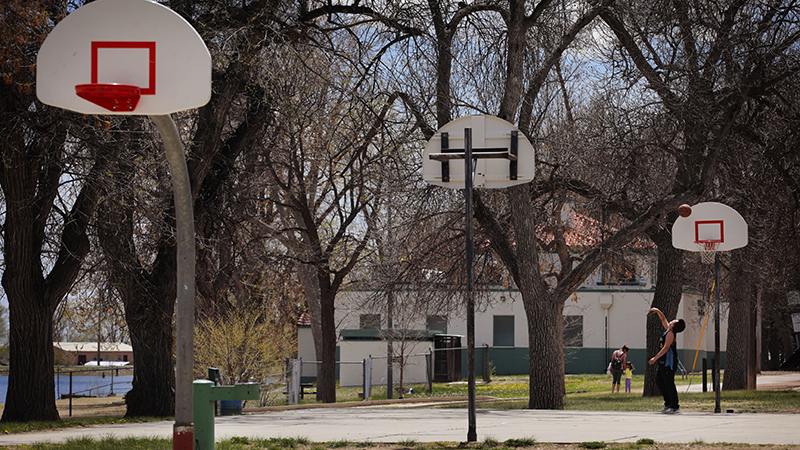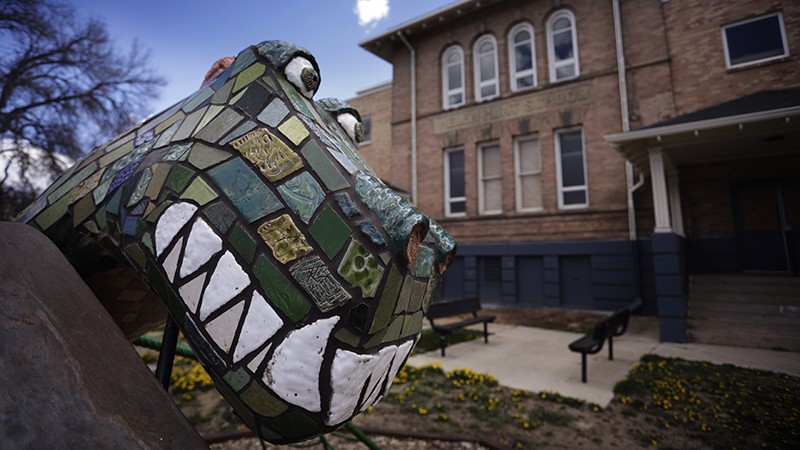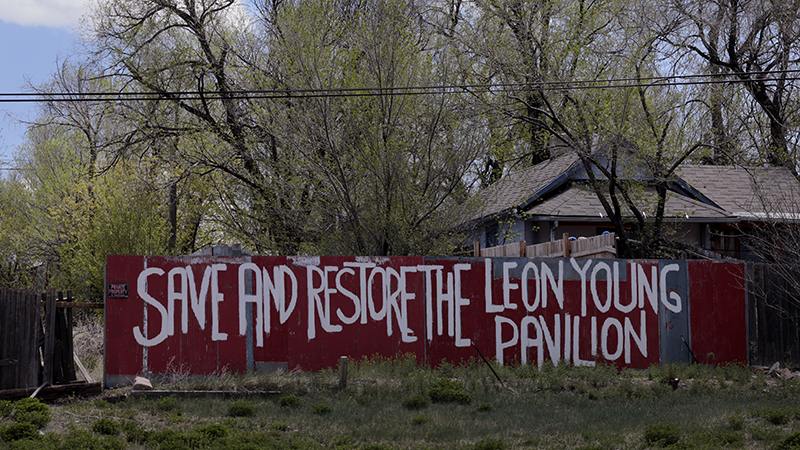Teenagers Get in Front in Colorado Springs
Leer en español
Victoria Gallegos and Faith Stone in front of a newly installed crosswalk near the Leon Young Pavilion in Colorado Springs. Photos by Joe Mahoney
By Mia Ramirez
Two years ago, if you were a young person living in the Hillside neighborhood of Colorado Springs, you couldn’t play basketball at Memorial Park. The courts had long been abandoned, and were now just concrete slabs with faded stripes and metal poles.
Two years ago, Helen Hunt Elementary School was a dark, vacant building where the neighborhood school once was.
Two years ago, many young people in Hillside had never heard of the Leon Young Pavilion, let alone spent any time in the overgrown, dilapidated wooden structure in a neglected park.
That has all changed now, thanks to the vision and leadership of Leaders Engaged and Amazingly Determined (LEAD), a local neighborhood youth group. The first two locations were revamped quickly; the third took much more work.
LEAD is led by Victoria Stone, a Hillside resident and leader. It is a labor of love, relying heavily on volunteers, in-kind donations and donated meeting space at the Hillside Community Center. In February 2017, LEAD partnered with The Colorado Trust on a Hillside neighborhood youth “photovoice” project. Photovoice is a process in which people—usually those with limited power due to poverty, language barriers, race, class, ethnicity, gender, culture or other circumstances—use video or photo images to capture their environment and experiences, and share them with others.
Victoria Stone’s daughter, Faith Stone, and Victoria Gallegos, who are both 17, were some of the first young people to sign up for the photovoice project. (Going forward, Stone refers to Faith, not her mother.) “I thought it was a good opportunity to show people my neighborhood,” said Stone.
Equipped with disposable cameras, they and their LEAD teammates walked their neighborhoods and began to take photos. They submitted photos of their friends and family, the community center, their pets and lots of food. They also captured things that they wanted to see changed in their communities: pictures of litter, abandoned grocery carts, overgrown weeds, crumbling sidewalks, potholes, loose pets, crosswalks, vacant buildings and boarded-up homes. After developing the photos, three places stood out: the abandoned basketball courts, the vacant school and the Leon Young Pavilion.
Within months, the LEAD photographs of the basketball courts reached a young man in the neighborhood, Terrell Brown, who had a vision for reinvigorating a local youth basketball team. Brown thought that the outdoor courts at Memorial Park would be perfect for his youth program, Hillside Connection. The idea quickly won support from the city parks department and funding from The Colorado Trust.

Volunteers restored two basketball courts for the use of neighbors in Hillside.
On a warm May morning in 2017, a group of neighborhood volunteers restriped the courts, replaced the backboards, and installed new hoops and nets. By afternoon, the courts hosted the first outdoor practice for Hillside Connection.
Meanwhile, LEAD youth were actively sharing their photos and visions for the shuttered Helen Hunt school. Before the start of the photovoice project, the Lane Foundation, a private family philanthropy, had purchased the building from Colorado Springs School District 11 for $1—a sum that raised concerns from neighbors who saw the space as a valuable one.
In public and private meetings, LEAD youth advocated for the return of educational programs, internship opportunities and to maintain public access to the playground spaces. Two years later, the Helen Hunt campus offers Head Start, English as a Second Language and other educational programs through the nonprofit partners currently housed there. LEAD youth were actively involved in the design and construction of a new playground (also supported with funding from The Colorado Trust), and several youth members of LEAD have taken internships or employment with the partner organizations.

Young people contributed their ideas to the design of a new playground outside a former elementary school.
The Leon Young Pavilion, their third priority, was not such a smooth process.
Stone and Gallegos said they specifically photographed the Leon Young Pavilion because they saw the potential in the location. They thought that it was a cool space and in need of some TLC. The pavilion was built in memory of the city’s first and only Black mayor.
But after early successes with the basketball courts and the school, they encountered unexpected obstacles. The city parks department resisted the idea of rebuilding the pavilion, citing a range of reasons from cost to other potential uses for the site.
“It was so hard to get things done,” said Gallegos. At a time when other high school kids are focused on school and friends, she showed up at community meetings, canvassed her neighborhood and spoke with neighborhood stakeholders and elected officials about the park.
When pushed to identify what made reimagining the pavilion so hard compared to the other photovoice priorities, Stone and Gallegos shared a look and said simultaneously: “The adults.”
Early in the process, they said, adults in their community and city employees began to dominate debates over the future of the Leon Young Pavilion. Officials from the city parks department showed little interest in LEAD’s original aspirations for the space, they said.
I asked Tilah Larson, an analyst with the parks department, to respond to this. Larson became aware of LEAD only after the parks department initially declined to work on revamping the pavilion; the community organized in response, and LEAD members played a prominent role.
“I truly didn’t know [LEAD] were the figures trying to push this forward,” Larson said. “Had I known, I would have tried to incorporate their voice into it, because I would have been more cognizant of how the adult voice can take over.”
Stone and Gallegos said they felt, if not invisible, then disregarded during the process.
“At times we were definitely talked to as if we were a part of the table and we were adults. But I definitely do think, in terms of what we had to say, it wasn’t taken as seriously,” said Stone. “Any comments and questions that we had were dismissed.”
Stone describes a lack of transparency from the city parks department. Officials may have told the media and the adults in the community that they were not planning to fix up the pavilion, but the message never reached the teenagers.
Gallegos became frustrated when the parks department asked the neighborhood to answer the same questions over and over. She also recalls times when the teenagers’ views came into conflict with those of the adults in the neighborhood: “I totally got shut down by the adults. There was no inclusion.”
Local media coverage also felt slanted at times. This put the two youth in precarious positions at school and in their community, they said.
“I didn’t really talk about it to anyone else. It was a big, stressful point in my life,” said Stone. “There were a couple articles where what we were doing was portrayed negatively in what we were trying to get done, so I didn’t want to tell anyone in case some of my teachers would think, ‘You’re the ones causing the ruckus.’”
They took issue with media portraying the community as angry activists—a characterization that is rarely applied to the primarily white neighborhood groups that are more commonly in the news for opposing Springs-area development.
“Colorado Springs is super white, and we are just a little brown community,” Stone said of Hillside. “We’re seen as more aggressive. We’re seen as making a mountain out of a molehill—like our problems aren’t real.
“There are stereotypes. I don’t think people expected for the brown people to make a ruckus. Here, they expect it to be coming from white people.”
At the same time, said Gallegos, the media missed the opportunity to showcase youth advocacy and leadership. “Youth did a lot of the work. I was at every single meeting and now I feel colored out of the picture,” she said.
Still, there were things they both loved about the process.
“In my neighborhood, you really don’t talk to anybody. We keep to ourselves,” said Stone. “It was cool to go out and meet new people. There is more sense of community.”
Bringing their concerns to a City Council meeting was another highlight. “It was cool but also super nerve-wracking,” said Stone. “They didn’t try to talk over me. They sat and listened, which was nice.”
Gallegos lit up when her friend mentioned that: “I did like talking to adults and meeting the head honchos and having them listen to me.”

The pavilion honoring the city’s first and only Black mayor has been neglected for years.
In the end, the neighborhood and the city parks department reached a compromise: The department agreed to rebuild the pavilion, with a Community Development Block Grant and additional funding from The Colorado Trust. With their hardest-won success behind them, how do Stone and Gallegos feel?
“I feel tired, honestly,” said Stone. She ended up feeling like the parks department had given them the runaround, and it was exhausting to have to fight so hard to be seen. “There was so much that went down and so much that happened, that I had a ‘Was it worth it?’ moment, to be honest. I am excited to get back to the park, but I think there are a lot of things we could have done without.” (She’s referring to unproductive and/or unpleasant interactions with parks department officials.)
Gallegos feels differently: “I haven’t gotten tired of it. [Advocating for the pavilion] hit a lot of my interests. I was into it. I like going to City Council meetings. I like that type of stuff.”
The two of them have advice for young people and adults alike who want to work for change in their communities.
“Talk to people in your neighborhood. Get to know them. The world is a lot better if you know the people around you and you feel safe,” said Stone. “Community and neighborhood meetings are beneficial. You get to know everyone in your neighborhood, and you know who you can count on to help out.”
Work with your elected officials and politicians, said Gallegos: “I feel like it was the politicians who were like, ‘We have to listen because it’s our job to listen to the people.’”
They have advice for the media, too.
“Celebrate the young people in your community taking a stand and doing what they’re passionate about,” said Stone.
“Give credit where credit is due,” added Gallegos. “I feel like [youth] didn’t get any credit for the process, and what really went into it, and how hard it really is to be a youth and try and do big adult things.”
For adults who want to work with youth to achieve their goals, their advice is to listen. “All teens are different. Not all of them have the same interests,” said Gallegos.
Stone added: “Respect everyone. If you are going to host meetings, create some housekeeping rules.”
Incentives also help young people feel welcomed and valued, they said. “Candy, fun stuff and snacks” help, said Stone—but also good energy, and opportunities to learn new skills and “talk to cool people like city council members.”
Larson, from the parks department, said learning about the young people’s experience makes her think differently about how to incorporate their feedback into public projects.
“They are right about what they want to see in the neighborhood,” she said. In the future, Larson said she wants to work harder to incorporate their vision. “What are the ways to integrate them now? We need to support more youth sentiment and encourage more youth power.”
Maybe, said Larson, that would mean youth advisory boards, intentionally putting youth voices in front of the media, having established roles for young people during public meetings, or giving them formal roles in programming or facilitation. She suggested that the LEAD youth come back to City Council and the parks board to provide updates and continued feedback.
Above all, Larson wants young people to continue to be a part of these conversations. Regarding LEAD’s work on all three of these Hillside projects, Larson said she “didn’t know they were involved and I feel like I missed the boat,” adding: “I am sorry they felt dismissed.”
Looking to the future, Stone and Gallegos said they feel more sad and anxious about gentrification than anything else. In Hillside, developers are buying up public property, flipping houses and razing entire housing complexes. The neighborhood just saw some of the highest property tax hikes in all of Colorado Springs, promising to put further financial pressure on longtime community members.
“A lot of people are coming to live in our neighborhood. [It] makes me think the long-term plan is to flip our neighborhood completely into some hipster, trendy neighborhood,” said Stone. “It feels like someone has gone in with three tons of bleach and is trying to get rid of any trace that we were there.”
At the same time, she added: “Here’s the thing with gentrification. There are cool things that can happen because people are more aware of your community and you get more positive things.”
“We don’t even have a school, and we are in a food desert,” Gallegos interrupted.
They both wonder who will get to enjoy the fruits of their efforts, as people they know are getting pushed out of their neighborhood by the rising costs of living here.
“I don’t know who is still going to be there in the next five years,” said Stone of Hillside. “I don’t know if I am still going to be there. It is going to be a lot different. It is going to feel different. It sucks to think I won’t be able to enjoy something that we got the word out about.”
Larson, while acknowledging the real economic pressures of gentrification, thinks the young people may be underestimating their own power.
“When you know your neighbor, and work together on issues, that can convince you to stay and not sell,” she said. “When there is a strong sense of community, people are less inclined to leave. They see value in their neighborhood, in their neighbors.”